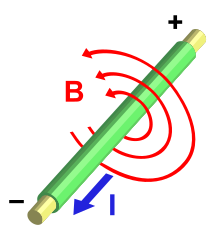
Back قانون أورستد Arabic ওয়েরস্টেডের সূত্র Bengali/Bangla Experiment d'Ørsted Catalan Ørstedi katse ET Loi d'Ørsted French Elektrodinamičko djelovanje Croatian Oersted-kísérlet Hungarian Esperimento di Ørsted Italian Ørsteds lov NB Doświadczenie Ørsteda Polish
This article may have misleading content. (October 2023) |
| Articles about |
| Electromagnetism |
|---|
 |

In electromagnetism, Ørsted's law, also spelled Oersted's law, is the physical law stating that an electric current induces a magnetic field.[2]
This was discovered on 21 April 1820 by Danish physicist Hans Christian Ørsted (1777–1851),[3][4] when he noticed that the needle of a compass next to a wire carrying current turned so that the needle was perpendicular to the wire. Ørsted investigated and found the physical law describing the magnetic field, now known as Ørsted's law. Ørsted's discovery was the first connection found between electricity and magnetism, and the first of two laws that link the two; the other is Faraday's law of induction. These two laws became part of the equations that govern electromagnetism, Maxwell's equations.
- ^ Presentation (2015) by O. Zajkov, Physics Institute, Ss. Cyril and Methodius University of Skopje, Macedonia.
- ^ Becker, Richard (2013). Electromagnetic Fields and Interactions. Courier Dover Publications. p. 172. ISBN 978-0486318509.
- ^ Oersted, H. C. (1820). "Experiments on the effect of a current of electricity on the magnetic needles". Annals of Philosophy. 16. London: Baldwin, Craddock, Joy: 273.
- ^ H. A. M. Snelders, "Oersted's discovery of electromagnetism" in Cunningham, Andrew Cunningham; Nicholas Jardine (1990). Romanticism and the Sciences. CUP Archive. p. 228. ISBN 0521356857.